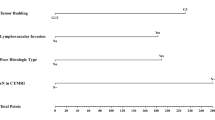Abstract
PURPOSE: An accurate determination of the extent or staging of a disease is critical, because it provides the basis for making therapeutic decisions. Staging is a collaborative effort by the surgeon and the pathologist. Radioimmunoguided surgery has been evaluated for its ability to help surgeons determine the extent of disease during surgery, when management decisions have the most impact on patient care. This study was done to compare radioimmunoguided surgery “biostaging” with traditional pathologic staging (TNM) as predictors of survival in patients undergoing curative resections for colorectal cancer. METHODS: Ninety-seven patients with colorectal cancer were prospectively enrolled in radioimmunoguided surgery protocols. Evaluation of follow-up survival data was performed. All patients underwent exploratory laparotomy and radioimmunoguided surgery with resection of their primary colorectal tumor. Survival data were analyzed with the Kaplan-Meier method with log-rank comparisons. RESULTS: Of 97 patients enrolled in the study, 59 were evaluable and completely resectable by radioimmunoguided surgery. Mean follow-up was 62 months, with a range of 34 to 89 months. By traditional staging 13 patients were pStage I, 18 patients were pStage II, and 28 patients were pStage III. By radioimmunoguided surgery biostaging, 24 patients were radioimmunoguided surgery-negative whereas 35 patients were radioimmunoguided surgery-positive. Survival rates by pathologic stage approached a significant difference, but did not, as of the conclusion of the study period, reach it (P=0.12). Survival rates based on radioimmunoguided surgery status demonstrated a highly significant difference (P=0.0002). CONCLUSIONS: Radioimmunoguided surgery biostaging provides new information intraoperatively on cancer staging that has not been available before. This may lead to new strategies for therapy that can be individualized and optimized for each patient with cancer.
Similar content being viewed by others
References
Steele G Jr. The surgical oncologist as a key translator of basic cancer: asking the right questions. Ann Surg Oncol 1994;1:262–9.
Fielding LP, Phillips RK, Fry JS, Hittinger AR. Prediction of outcome after curative resection for large bowel cancer. Lancet 1986;2:904–7.
Arnold MW, Schneebaum S, Berens A,et al. Intraoperative detection of colorectal cancer with radioimmunoguided surgery and CC49, a second generation monoclonal antibody. Ann Surg 1992;216:627–32.
Martin EW Jr, Thurston MO. The use of monoclonal antibodies and the development of an intraoperative hand-held probe for cancer detection. Cancer Invest 1996;14:560–571.
Paget S. The distribution of secondary growths in cancer of the breast. Lancet 1889;1:571–3.
Fidler IJ. Cancer metastasis [review]. Br Med Bull 1991;47:157–77.
Arnold MW, Young DC, Hitchcock CL,et al. Radioimmunoguided surgery in primary colorectal carcinoma: an intraoperative prognostic tool and adjuvant to staging. Am J Surg 1995;170:315–8.
Bertsch DJ, Burak WE, Young DC. Radioimmunoguided surgery for colorectal cancer. Ann Surg Oncol 1996;3:310–6.
Tsakraklides V, Wanebo HJ, Sternberg SS, Stearns M, Good RA. Prognostic evaluation of regional lymph node morphology colorectal cancer. Am J Surg 1975;129:174–80.
Patt DJ, Brynes RK, Vardiman JW, Coppleson LW. Mesocolic lymph node histology is an important prognostic indicator for patients with carcinoma of the sigmoid colon: an immunomorphologic study. Cancer 1975;35:1388–96.
Tsakraklides V, Olson P, Kersey JH, Good RA. Prognostic significance of the regional lymph nodes histology in cancer of the breast. Cancer 1974;34:1259–67.
Hunter RL, Ferguson DJ, Coppleson LW. Survival with mammary cancer related to the interaction of germinal center hyperplasia and sinus histiocytosis in axillary and internal mammary lymph nodes. Cancer 1975;36:528–39.
Coppleson LW, Brown B. Observations on a model of the biology of carcinoma of the cervix: a poor fit between observation and theory. Am J Obstet Gynecol 1975;122:127–36.
Gastrointestinal Tumor Study Group. Adjuvant therapy of colon cancer: Results of a prospectively randomized trial. N Engl J Med 1984;310:737–43.
Author information
Authors and Affiliations
Additional information
This work was supported in part by Grant P30CA16058, National Cancer Institute, Bethesda, Maryland and by the Neoprobe Corp., Dublin, Ohio.
About this article
Cite this article
Arnold, M.W., Young, D.M., Hitchcock, C.L. et al. Staging of colorectal cancer: Biologyvs. morphology. Dis Colon Rectum 41, 1482–1487 (1998). https://doi.org/10.1007/BF02237292
Issue Date:
DOI: https://doi.org/10.1007/BF02237292




